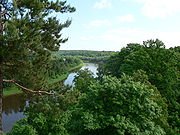.gif)
Punia (town)
Encyclopedia


Alytus district municipality
The Alytus district municipality is a municipality in Lithuania, located in the Dzūkija ethnographic region.This municipality was founded in 1950, and until 1953 was a part of the Kaunas province. In 1959, another reorganization of parts of the former Simnas and Daugai municipalities occurred,...
, Lithuania
Lithuania
Lithuania , officially the Republic of Lithuania is a country in Northern Europe, the biggest of the three Baltic states. It is situated along the southeastern shore of the Baltic Sea, whereby to the west lie Sweden and Denmark...
. Situated on the right bank of the Neman River
Neman River
Neman or Niemen or Nemunas, is a major Eastern European river rising in Belarus and flowing through Lithuania before draining into the Curonian Lagoon and then into the Baltic Sea at Klaipėda. It is the northern border between Lithuania and Russia's Kaliningrad Oblast in its lower reaches...
, it has a population of about 800. It was an important early city of the Grand Duchy of Lithuania
Grand Duchy of Lithuania
The Grand Duchy of Lithuania was a European state from the 12th /13th century until 1569 and then as a constituent part of Polish-Lithuanian Commonwealth until 1791 when Constitution of May 3, 1791 abolished it in favor of unitary state. It was founded by the Lithuanians, one of the polytheistic...
.
The town was first mentioned in 1382. The first church was built in 1425, likely by Vytautas the Great
Vytautas the Great
Vytautas ; styled "the Great" from the 15th century onwards; c. 1350 October 27, 1430) was one of the most famous rulers of medieval Lithuania. Vytautas was the ruler of the Grand Duchy of Lithuania which chiefly encompassed the Lithuanians and Ruthenians...
. Because of its good geographical location (Neman River, direct route to Trakai
Trakai
Trakai is a historic city and lake resort in Lithuania. It lies 28 km west of Vilnius, the capital of Lithuania. Because of its proximity to Vilnius, Trakai is a popular tourist destination. Trakai is the administrative centre of Trakai district municipality. The town covers 11.52 km2 of...
), Punia became a local center. In 1503 the town received Magdeburg rights
Magdeburg rights
Magdeburg Rights or Magdeburg Law were a set of German town laws regulating the degree of internal autonomy within cities and villages granted by a local ruler. Modelled and named after the laws of the German city of Magdeburg and developed during many centuries of the Holy Roman Empire, it was...
and was promoted to city
City
A city is a relatively large and permanent settlement. Although there is no agreement on how a city is distinguished from a town within general English language meanings, many cities have a particular administrative, legal, or historical status based on local law.For example, in the U.S...
status. In the 17th century the city reached its peak, and became known for its pottery and smithery. In 1688 the third church was built. At the beginning of the 18th century, Punia suffered a great deal of damage from the Swedish wars, and did not recover until the end of the century. In 1785 a town hall was built. During the middle of the 19th century Jews settled in the town, developing trade and helping the town recover from two large fires. After the second fire a new brick church replaced the old wooden church. By 1866 the number of residents had almost doubled since 1833, reaching 1,000. Punia suffered from another major fire, the World Wars, Soviet repressions and by 1939 it had only about 200 residents left. It recovered a bit only in the 1960s, when it became the administrative center of the local kolkhoz
Kolkhoz
A kolkhoz , plural kolkhozy, was a form of collective farming in the Soviet Union that existed along with state farms . The word is a contraction of коллекти́вное хозя́йство, or "collective farm", while sovkhoz is a contraction of советское хозяйство...
.
Punia is proud of the Hill of Margiris , one of the largest hill fort
Hill fort
A hill fort is a type of earthworks used as a fortified refuge or defended settlement, located to exploit a rise in elevation for defensive advantage. They are typically European and of the Bronze and Iron Ages. Some were used in the post-Roman period...
s in Lithuania, in the bend of the Neman River
Neman River
Neman or Niemen or Nemunas, is a major Eastern European river rising in Belarus and flowing through Lithuania before draining into the Curonian Lagoon and then into the Baltic Sea at Klaipėda. It is the northern border between Lithuania and Russia's Kaliningrad Oblast in its lower reaches...
. It is believed to be the location of legendary Pilėnai
Pilenai
Pilėnai was a fortress in medieval Lithuania. It is well known in the Lithuanian history due to the heroic defense of the castle.-Defence:The defence, led by the Duke Margiris, took place on February 25, 1336, when the castle was besieged by the army of the Teutonic Knights...
which was destroyed in 1336 by the Teutonic Knights
Teutonic Knights
The Order of Brothers of the German House of Saint Mary in Jerusalem , commonly the Teutonic Order , is a German medieval military order, in modern times a purely religious Catholic order...
. The heroic defence of the castle is described by Władysław Syrokomla in his poetic novel "Margier". The castle was rebuilt in 16th century only to be soon destroyed again.

